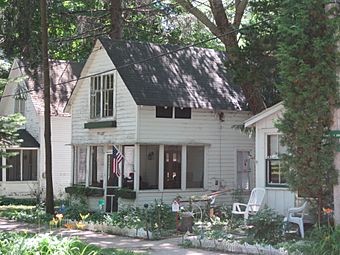Des Plaines Methodist Camp Ground facts for kids
Quick facts for kids |
|
|
Des Plaines Methodist Camp Ground
|
|
 |
|
| Lua error in Module:Location_map at line 420: attempt to index field 'wikibase' (a nil value). | |
| Location | 1900 E Algonquin Road, Des Plaines, Illinois |
|---|---|
| Area | 35 acres (14 ha) |
| Built | 1860/1865 |
| Architect | Fugard and Thielbar |
| Architectural style | Late Victorian, Camp Meeting Cottages |
| NRHP reference No. | 05000429 |
| Added to NRHP | May 22, 2005 |
The Des Plaines Methodist Camp Ground is a special historic place in Des Plaines, Illinois, USA. It's a church camp that has been around for a very long time. People have gathered here for over 160 years to express their Christian faith.
Contents
Des Plaines Methodist Camp Ground
How the Camp Started
The idea for the camp began in 1860. A group of Methodist ministers and business people started an annual camp meeting. They chose a beautiful spot along the Des Plaines River. This land belonged to Squire Socrates Rand.
After the US Civil War ended in 1865, the group bought about 25 acres of land from Squire Rand. This land was downstream and just as pretty. People donated money to buy it. Since then, meetings have happened every year without stopping.
In 1867, the Chicago District Camp Ground Association was officially created. This group still runs the camp today. It is led by a Board of Trustees who are chosen by vote.
Why This Location Was Chosen
The camp's location was picked because it was close to Chicago, about 16 miles away. Squire Rand's land was also near a C&NW train line. A popular road from Evanston, IL, home to Northwestern University, also ran nearby.
This made it easy for people from all over the Midwest to come together. They could share their Christian faith in a peaceful outdoor setting.
Life at the Early Camp Meetings
In the early years, every summer, religious Methodists would set up tents in the groves. It was like a temporary tent city. They even built wooden walkways with signs.
A large open area became the main worship space. Here, ministers and choirs would stand on a platform to speak and sing. Sometimes, as many as 10,000 people would fill the groves for these big meetings.
Eventually, a train station was built right at the camp. This saved people from having to walk a mile from downtown Des Plaines. The old ticket booth still stands near Campground Road today.
Building Permanent Cottages
By the mid-1860s, people who came to the camp often got tired of setting up tents. So, they started building small, temporary cottages. These cottages were meant to last for about 5 to 10 years.
However, many of these early cottages are still standing today! Most of the 100 cottages you see now were built between 1870 and 1930. They all have a similar look, following a late Victorian architecture style. This style is also seen in places like Martha's Vineyard.
Important Meeting Buildings
Over the years, several important buildings were constructed for the many gatherings. In 1903, the American Tabernacle was built. It was designed like the Eiffel Tower, meaning it had no support pillars inside. This way, everyone could see the stage clearly.
This building was later named the Waldorf Tabernacle, after Bishop Ernest Lynn Waldorf. Its round shape reminds people of the original tents. It also looks like other similar tabernacles built for Chautauqua meetings across the United States. The cottages built around this circular building are some of the oldest ones still standing. All the cottages are built on paths that lead to at least one of the camp's many tabernacles.
In 1906, the current Wesley Tabernacle was built. It was originally called the Swedish Tabernacle. There was also a small, round Norwegian Tabernacle that could be seen from Algonquin Road. Sadly, it collapsed in the late 1990s due to heavy snow. In the early days, groups of Swedes, Germans, Norwegians, and other ethnic groups often spoke their native languages. This led to some separation, but it faded over time as people became more integrated.
Famous Visitors to the Camp
Many well-known people visited the Des Plaines Methodist Camp Ground. These included famous Christian figures like D.L. Moody, Frances E. Willard, Billy Sunday, and Mahalia Jackson. They were popular speakers and performers, both locally and internationally.
The Camp Today
The Camp Meeting happened every year without stopping from 1860 until the early 2000s. Around that time, the way the camp meeting was organized changed. It was given a new name and a new format.
Today, the camp still holds Sunday worship services and special events during the summer. People continue to own and rent cottages there from May to October. One cottage is used by a caretaker who lives there all year round.
In the past, minor floods would happen about every seven years in the spring. These floods caused very few problems for the campers. However, because of a lot of building in areas around the Des Plaines River, the camp now experiences more floods each year. Sometimes, the water can rise so high that it covers the first floor of some two-story cottages.
The Des Plaines Methodist Camp Ground was added to the National Register of Historic Places in 2005. This means it is recognized as an important historical site.

